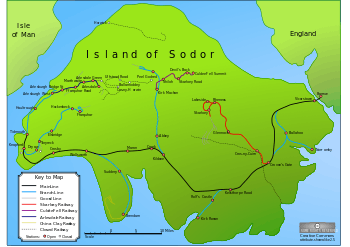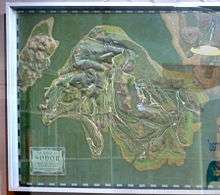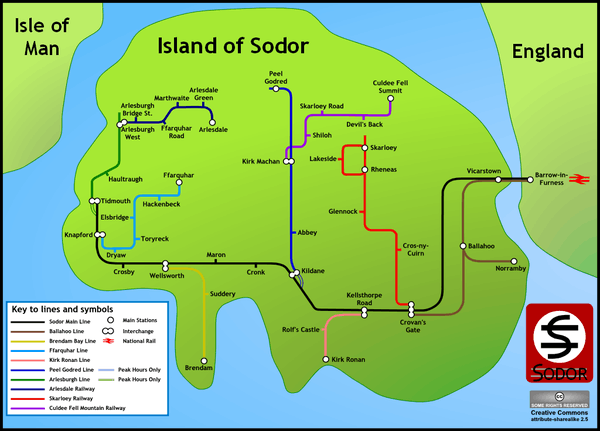Sodor (fictional island)

Sodor is a fictional island located in the Irish Sea, just off the English mainland near Barrow-in-Furness in Cumbria. It is used as the setting for The Railway Series books by the Rev. W. Awdry, and later used in the Thomas the Tank Engine and Friends television series.
Inspiration and creation
The need for consistency in the locations for The Railway Series necessitated the creation of a suitable location. Awdry required a setting for his books that would be within Great Britain,Rule[›] but would be sufficiently isolated from the rest of British Railways to allow him to do as he wished with the location.
Inspiration came on a visit to the Isle of Man, which forms the Diocese of Sodor and Man[1] in 1950. Awdry noted that while there was an Isle of Man, there was no similar Island of Sodor. A large island would meet the criteria he required, giving him the isolation from changes to the British railway system while giving him somewhere that people could believe in.
Between them, Awdry and his younger brother George worked out Sodor's history, geography, industry and language ("Sudric"). Inspiration came from various sources. Dryaw was an anagram of Awdry. Elsbridge was named after Wilbert's parish of Elsworth. Some place names were Sudric equivalents or near-equivalents of those in the real world (for instance, Skarloey was a rough Sudric equivalent of the Welsh Talyllyn: logh (Manx) = llyn (Welsh) = "lake"). By the time they had finished, they knew more about Sodor than would ever be used in the Railway Series stories.
Their abridged notes were published in 1987 in a book entitled The Island of Sodor: Its People, History and Railways.
Etymology
The bishop of the Isle of Man is known as Bishop of "Sodor and Man". This is because the Isle of Man was part of the Kingdom of Mann and the Isles, which included the Hebrides, known in Old Norse as the Suðreyjar,[2] (anglicised as "The Sudreys"[1]) i.e. "Southern Isles" compared to Norðreyjar ("The Nordreys"[1]), or the "Northern Isles", i.e. Orkney and Shetland. The Sudreys became "Sodor",[1] which was fossilised in the name of the Diocese, long after it ceased to have any authority over the Scottish Islands.
Thus there is no Island of Sodor; rather, the fictional island takes its name from an archipelago.
Awdry was intrigued to find that although the Bishop had the title "Sodor and Man", he had only Man for his diocese. "Everybody knew that there was an Isle of Man, but we decided to 'discover' another island – the Island of Sodor – and so give the poor deprived Bishop the other half of his diocese!" (Rev. W. Awdry)[1] Hence Awdry sited Sodor in the Irish Sea, between the Isle of Man and Barrow-in-Furness in Cumbria (then in Lancashire).[1]
Language
The historical language of Sodor is "Sudric", a language similar to Manx and, like Manx, is falling out of use. Manx and Sudric are similar enough to be mutually intelligible.[3]
A lot of the place names on Sodor are clearly based on Manx forms, but often the nouns are inverted to match English word order. Some of the locations have quasi-Manx names, e.g. Killdane, which comes from "Keeill-y-Deighan" (Church of the Devil),[4] hills are called Knock and Cronk, while "Nagh Beurla", means "I speak no English",[3] a distortion of the Manx. The names of some of the 'historical' characters – used in the background but not appearing in the stories – were taken from locations on the Isle of Man, such as Sir Crosby Marown (Crosby is a village in the parish of Marown) and Harold Regaby (Regaby is a tiny hamlet on the parish boundary between Andreas and Bride).[5]
Geography
Sodor is usually shown as much larger than the Isle of Man. The island is roughly diamond-shaped, 62 miles (100 km) wide east to west and 51 miles (82 km) long north to south. Its north-west coast is separated from the Isle of Man by a sea strait called the Sudrian Sea, four miles (6 km) wide. Its north-east edge overrides and replaces the real Walney Island.
The place names on Sodor are mostly a mixture of Manx and Norse. Its highest mountain is Culdee Fell, which was modelled on Snowdon: the ridge of Devil's Back copies the Clogwyn ridge on Snowdon. The summit is reached by the Culdee Fell Railway, which is based on the Snowdon Mountain Railway in Wales.
The capital and administrative centre of Sodor is the city of Suddery, however, Tidmouth has grown to be the largest town on the island. One of the more famous settlements on Sodor is Ffarquhar, the terminus of Thomas the Tank Engine's Branch Line.
All of the other settlements on the island are described in Locations on the Island of Sodor, while the six railway lines from The Railway Series are described below.
Railways
The railways of Sodor include both standard-gauge and narrow-gauge railways. The first few stories concerned standard-gauge engines (including Thomas the Tank Engine). Stories set in the narrow gauge railways soon followed.
The standard-gauge railway system consists of a main line and several branch lines. They are linked to and interoperable with each other and with the mainland system, so the standard-gauge engines can visit London (for example) under their own power. In the story Gordon Goes Foreign several of the engines recount their stories of working in London when they were younger, and later in the same story Gordon pulls a train of mainland rolling stock to London. In the story The Fat Controller's Engines several of the famous engines visit London, and run on the mainland permanent way to get there.
There are three narrow-gauge railways, the Skarloey Railway, in addition to rack-and-pinion Culdee Fell mountain railway, and the 15 inch-gauge Arlesdale Railway, each isolated from the other. Movements of rolling stock (particularly engines) to and from the narrow-gauge railways is achieved by transporting them on flatbeds on the standard-gauge system, for example when Rheneas is sent away for repairs in a flashback in the story Skarloey Remembers and later returned in the story Gallant Old Engine.
Each of the three narrow-gauge railways links to the standard-gauge system at an interchange station:
- the Skarloey Railway at Crovan's Gate
- the Culdee Fell Railway at Kirk Machan
- the Arlesdale Railway at Arlesburgh West
History

"Research"[6] conducted by Awdry has revealed most of the known history concerning the railways on the Island of Sodor.
The first railway on the island, dating from 1806, was a horse-worked plateway from Cros-ny-Cuirn to Balladwail,[6] a port south-east of Crovan's Gate, which is no longer rail-connected. Pack horses brought copper ore from a mine in the mountains down to Cros-ny-Cuirn, where it was loaded into wagons for the journey to the port. In 1820 the Crovan's Gate Mining Company extended the line up the valley to the mine by building a series of five inclined planes. At the same time, the rest of the 1806 line was rebuilt with fish-belly edge rail. The line continued in use until the Skarloey Railway was built, after which it was abandoned, although the overgrown remains can still be seen to this day.
The second railway, the Cronk and Harwick Railway, was established in 1830 as a coal line transporting coal to the Harwick docks as well taking miners to work. In 1854 the coal played out and the mines and railway closed. Its locomotives and rolling stock were sold off to other lines in the UK.
A government-sponsored amalgamation of the standard-gauge railways in the Island occurred in 1914 to build a strategic railway for coastal defence called the North Western Railway. The railways concerned were:
- the Sodor & Mainland Railway (1853–1914) which ran from Ballahoo to Kirk Ronan
- the Tidmouth, Knapford & Elsbridge Railway (1883–1914) from Tidmouth to Elsbridge (the railway was known as the Knapford & Elsbridge Railway until 1908 when line extended to Tidmouth)
- the Wellsworth & Suddery Railway (1870–1914), which ran from Crosby to Brendam, with an extension from Crosby to Knapford in 1912 to amalgamate with the Tidmouth, Knapford & Elsbridge Railway
The North Western Railway has had running rights into Barrow Central Station since the agreement with the London, Midland and Scottish Railway in 1925. There is a Scherzer rolling lift bridge of 120 ft (37 m) span and double track over the Walney Channel, designed by Topham Hatt and erected in 1915. The NWR built its headquarters at Vicarstown in 1915, but the administrative offices relocated to Tidmouth in 1926. Until the construction of the Jubilee Road Bridge in 1977, the NWR had rights for a car-ferry and worked an intensive and profitable service. British Rail had running powers over the Bridge to operate the joint NWR/BR suburban service from Barrow to Norramby.
On through- or express-trains, engines from the NWR are detached at Barrow and "Other Railway" engines take over. Since 1925 the NWR has also had its own loco shed, turntable and servicing facility here. There is also a joint goods-yard for exchange traffic.
With the nationalisation of the railways in the United Kingdom, the North Western Railway became the North Western Region of British Railways. It was allowed to keep a large degree of independence from the rest of the network, which explains why steam traction survived. The other railways on the island were not affected by the nationalisation. Since privatisation, the railway has again become the North Western Railway Company and, unlike most post-privatisation train companies, is responsible not just for the running of the freight and passenger operations, but also for the maintenance of the track and of the infrastructure of the railway.
Current system (passenger)

All of the railway lines created in The Railway Series have their own pages with information on routes and the stations served.
- The North Western Railway is the main railway company featured in the book. It controls the mainline railway and many of the branch lines on the island and is often referred to as The Fat Controller's Railway.
- The Mainline runs from Barrow on the mainland, joining the island at Vicarstown and transversing the island to Tidmouth. Its main traffic is Gordon's express which has to safely navigate Gordon's Hill.
- Thomas' Branch Line runs from Knapford to Ffarquhar
- Edward's Branch Line goes from Brendam to Wellsworth. It links the china-clay works at Brendam to the mainline.
- The Little Western, known as Duck's Branch Line, runs along the coast from Tidmouth to Arlesburgh.
- The Peel Godred Branch runs from Kildane to Peel Godred and connects with the Culdee Fell Railway.
- Three other North Western Railway branch lines detailed on the maps of Sodor have not featured in The Railway Series. They run from:
- Vicarstown to Norramby, via Ballahoo
- Ballahoo to Crovan's Gate
- Kellsthorpe Road to Kirk Ronan
- The Arlesdale Railway or Small Railway, a minimum-gauge railway, takes waste from the mines in the hills to Arlesburgh where it could be distributed to the rest of the Island. It also carries tourists.
- The Culdee Fell Railway, a narrow-gauge rack-and-pinion mountain railway, runs from the summit of Culdee Fell down to Kirk Machan where it links to the standard-gauge line from Kildane to Peel Godred.
- The Mid Sodor Railway, a narrow-gauge railway, closed in 1947. It ran from Arlesburgh to King 'Orry's Bridge. Part of its route is now on the Arlesdale Railway.
- The Other Railway refers to the nationalised British Railways company that ran the Railway System in the United Kingdom until 1997.
- The Skarloey Railway, a narrow-gauge railway, runs from Crovan's Gate up to the slate works at Skarloey.
On screen portrayal
The Island of Sodor in the Thomas the Tank Engine and Friends television series differs significantly from that in the books. Wilbert and George Awdry's notes have been largely overlooked. The television version of Sodor appears quite larger and has more industry. The connection to the British mainland wasn't acknowledged until the 2013 special "King of the Railway", which introduces "The Vicarstown Rolling Bridge", connecting Sodor to mainland England.
In the movie Thomas and the Magic Railroad (2000), the Island was portrayed vastly differently to either the Railway Series or the television series. Sodor was a magical land that was supported by a magical railway line called The Magic Railroad. Without the Magic Railroad, the island would vanish off the face of the Earth. In the film, one could only travel to Sodor via The Magic Railroad or gold dust. This means the only way Diesel 10 and Splodge (Splatter and Dodge) could have arrived on Sodor is via boat.
Notes
^ Rule:
In The Island of Sodor: Its People, History and Railways, Awdry explained how Sodor was politically part of the United Kingdom. While the Isle of Man had retained Home Rule, since the 15th century Sodor had been attached to the Duchy of Lancaster and is therefore part of England, although this has not been allowed to disturb the Sudrian's independent way of life.
References
- 1 2 3 4 5 6 Sibley, Brian (1995). The Thomas the Tank Engine Man. Heinemann. p. 154. ISBN 0-434-96909-5.
- ↑ Anderson, Joseph (Ed.) (1893) Orkneyinga Saga. Translated by Jón A. Hjaltalin & Gilbert Goudie. Edinburgh. James Thin and Mercat Press (1990 reprint). ISBN 0-901824-25-9
- 1 2 The Rev. W. Awdry; G Awdry (1987). The Island of Sodor: Its People, History and Railways. Kaye & Ward. p. 5. ISBN 0-434-92762-7.
- ↑ The Rev. W. Awdry; G Awdry (1987). The Island of Sodor: Its People, History and Railways. Kaye & Ward. p. 12. ISBN 0-434-92762-7.
- ↑ Sibley, Brian (1995). The Thomas the Tank Engine Man. Heinemann. p. 159. ISBN 0-434-96909-5.
- 1 2 Awdry; G Awdry (1987). The Island of Sodor, its People, History, and Railways. Kaye & Ward. ISBN 0-434-92762-7.
Further reading
- Timpson, Trevor (4 July 2011). "Where is Sodor, home of Thomas the Tank Engine?". BBC News website. Retrieved on 4 July 2011.